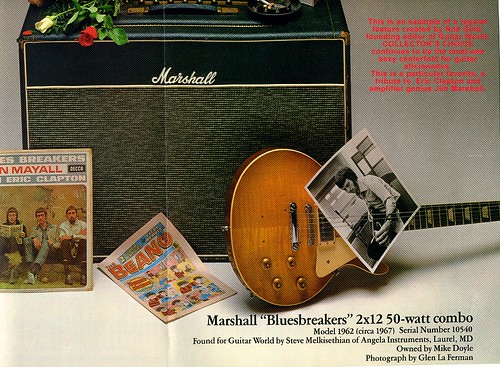I have commented before about this Clapton session. You can see a print of Slowhand from February, 1966 on this pic clipped to the strings of a Les Paul guitar, which was staged as Guitar World's Collectors Choice Centerfold Honoring the Marshall "Bluesbreaker" 2x12 50-watt combo Model 1965340.
The amp – the Marshall "Bluesbreaker" 2x12 named for the album on which it was used – was found for me by the honorable Steve Melkisethian of Angela Instruments in Laurel, Maryland (Steve later got me the "Bullet" harp mike dedicated by Billy Gibbons to me, and which I still use, but that is another story). I orchestrated the whole setup in the studio for GW "Guitographer" Glen La Ferman's loving homage. The amp is owned by Mike Doyle of Guitar Center in CA.
Of the amp, Pete Prown, Gear Editor of Vintage Guitar magazine, said recently, "This is Ground Zero for rock-guitar tone. This is when it all exploded ... Hendrix, Beck, Cream, Zep -- they all took their cues from the Bluesbreakers album, tone-wise. It wasn't fuzz. It was TUBE tone."
Here's some more fab facts about Beanos, Bluesbreakers and that guy they used to call God:
Blues Breakers is an album credited to John Mayall With Eric Clapton, released in 1966. It peaked at #6 on the UK chart. In 2003. The album was ranked number 195 on Rolling Stone magazine's list of the 500 greatest albums of all time. Apart from being one of the most influential blues albums, it also started the now-legendary combination of a Gibson Les Paul guitar through an overdriven Marshall Bluesbreaker amplifier.
The band name John Mayall & the Bluesbreakers is derived from the title of this album; no original issues mention the Bluesbreakers as band name. The album was also known as The Beano Album because of its cover photograph showing Clapton reading The Beano, a British children's comic. Clapton stated in his autobiography that he was reading Beano on the cover because he felt like being "uncooperative" during the photo shoot.
Originally, John Mayall intended for his second album to be a live album in order to capture the guitar solos performed by Eric Clapton. A set was recorded at the Flamingo Club, with Jack Bruce (with whom Clapton would later work in Cream) on bass.
The recordings of the concert, however, were of bad quality and were scrapped. With the original plan of a live album now discarded, John Mayall & the Bluesbreakers recorded Blues Breakers with Eric Clapton at Decca Studios, West Hampstead in March, 1966. The guitar that Eric Clapton used during the sessions was a 1960 Gibson 'sunburst' Les Paul with two PAF (Patent Applied For) 'humbucker' pickups.
This guitar, whose whereabouts are currently unknown, is also known as the "Beano" Les Paul, a replica of which has recently been reissued by Gibson.
By Noë Gold Doctor Noe is a veteran cultural commentator, former Features Editor at the Hollywood Reporter and Founding Editor of Guitar World. For the complete interview of Frank Zappa by Noë Gold for Guitar World, go to http://wiki.killuglyradio.com/wiki/Zappa%27s_Inferno
Monday, October 29, 2012
Clapton's Beano Period
Subscribe to:
Comments (Atom)
